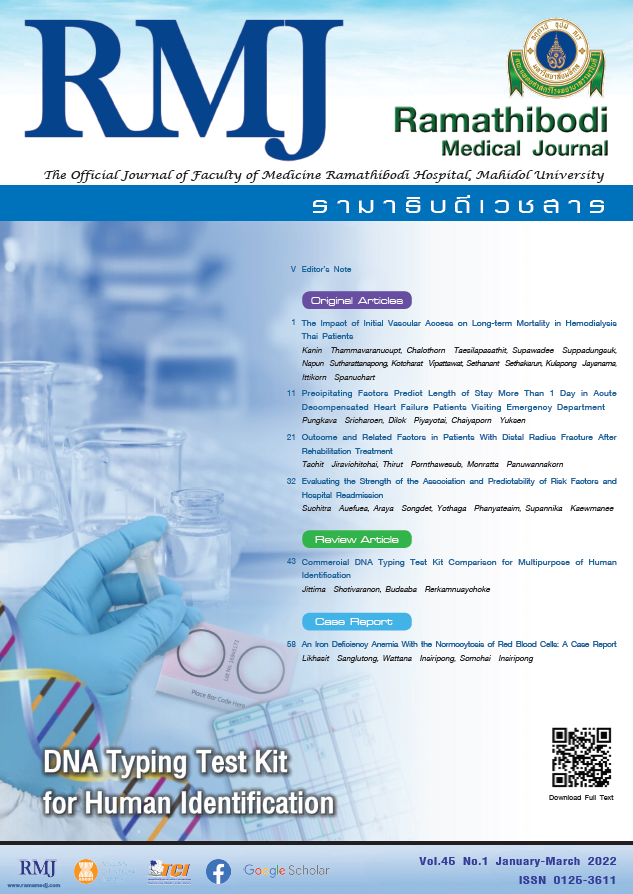Evaluating the Strength of the Association and Predictability of Risk Factors and Hospital Readmission
DOI:
https://doi.org/10.33165/rmj.2022.45.1.242686Keywords:
Risk assessment tool, Hospital readmission, Relative riskAbstract
Background: Hospital readmission is still a major public health problem. In many counties, there are the incidents that affected to performance of quality in the hospital.
Objective: To evaluate the strength of association and predictability of risk factors and hospital readmission.
Methods: The data of 160 patients referred to home health care unit at Ramathibodi Hospital were collected using risk assessment of unplanned readmission within 28 days. The strength of association and predictability of risk factors and hospital readmission were performed using relative risk (RR) and logistic regression.
Results: Factors significantly related to hospital readmission were number of previous hospital admission more than 1 time within the last 12 months (RR > 4), age more than 70 years (RR > 2), pneumonia (RR > 2), and diabetes (RR < 1). The predictability of 2 factors model including number of previous hospital admission more than 1 time within the last 12 months and diabetes was 86.3%.
Conclusions: Risk factors significantly associated with hospital readmission were number of previous hospital admission more than 1 time within the last 12 months, age more than 70 years, pneumonia, and diabetes. Number of previous hospital admission more than 1 time within the last 12 months and diabetes factors can be predicted hospital readmission.
References
Shuster C, Hurlburt A, Tam P, Staples JA. Unplanned hospital readmissions in British Columbia. BCMJ. 2018;60(5):263-267. Accessed December 28, 2021. https://www.bcmj.org/sites/default/files/public/BCMJ_Vol60_No5_hospital_readmissions.pdf
Hines AL, Barrett ML, Jiang HJ, Steiner CA. Conditions With the Largest Number of Adult Hospital Readmissions by Payer, 2011: HCUP Statistical Brief #172. Agency for Healthcare Research and Quality; 2014. Accessed December 28, 2021. http://www.hcup-us.ahrq.gov/reports/statbriefs/sb172-Conditions-Readmissions-Payer.pdf
Bosco JA 3rd, Karkenny AJ, Hutzler LH, Slover JD, Iorio R. Cost burden of 30-day readmissions following Medicare total hip and knee arthroplasty. J Arthroplasty. 2014;29(5):903-905. doi:10.1016/j.arth.2013.11.006
Trakulthong C, Phunmanee A. Mortality risk factors during readmission at the Department of Medicine. Ther Clin Risk Manag. 2017;13:1551-1554. doi:10.2147/TCRM.S142114
Bureau of Nursing, Department of Medical Services, Ministry of Public Health. Nursing Standards in Hospitals. 3rd ed. WVO Thai Printing; 2008:87.
Van Galen LS, Brabrand M, Cooksley T, et al. Patients’ and providers’ perceptions of the preventability of hospital readmission: a prospective, observational study in four European countries. BMJ Qual Saf. 2017;26(12):958-969. doi:10.1136/bmjqs-2017-006645
Casalini F, Salvetti S, Memmini S, et al. Unplanned readmissions within 30 days after discharge: improving quality through easy prediction. Int J Qual Health Care. 2017;29(2):256-261. doi:10.1093/intqhc/mzx011
Granda-Cameron C, Behta M, Hovinga M, Rundio A, Mintzer D. Risk factors associated with unplanned hospital readmissions in adults with cancer. Oncol Nurs Forum. 2015;42(3):E257-E268. doi:10.1188/15.ONF.E257-E268
Park L, Andrade D, Mastey A, Sun J, Hicks L. Institution specific risk factors for 30 day readmission at a community hospital: a retrospective observational study. BMC Health Serv Res. 2014;14:40. doi:10.1186/1472-6963-14-40
Snyderman D, Salzman B, Mills G, Hersh L, Parks S. Strategies to help reduce hospital readmissions. J Fam Pract. 2014;63(8):430-438a.
Graham KL, Dike O, Doctoroff L, et al. Preventability of early vs late readmissions in an academic medical center. PLoS One. 2017;12(6):e0178718. doi:10.1371/journal.pone.0178718
Low LL, Liu N, Wang S, Thumboo J, Ong ME, Lee KH. Predicting 30-day readmissions in an Asian population: building a predictive model by incorporating markers of hospitalization severity. PLoS One. 2016;11(12):e0167413. doi:10.1371/journal.pone.0167413
Diplock G, Ward J, Stewart S, et al. The Alice Springs Hospital Readmission Prevention Project (ASHRAPP): a randomised control trial. BMC Health Serv Res. 2017;17(1):153. doi:10.1186/s12913-017-2077-7
Blecker S, Herrin J, Kwon JY, Grady JN, Jones S, Horwitz LI. Effect of hospital readmission reduction on patients at low, medium, and high risk of readmission in the medicare population. J Hosp Med. 2018;13(8):537-543. doi:10.12788/jhm.2936
Robinson R. The HOSPITAL score as a predictor of 30 day readmission in a retrospective study at a university affiliated community hospital. PeerJ. 2016;4:e2441. doi:10.7717/peerj.2441
Su MC, Chen YC, Huang MS, et al. LACE score-based risk management tool for long-term home care patients: a proof-of-concept study in Taiwan. Int J Environ Res Public Health. 2021;18(3):1135. doi:10.3390/ijerph18031135
van Walraven C, Dhalla IA, Bell C, et al. Derivation and validation of an index to predict early death or unplanned readmission after discharge from hospital to the community. CMAJ. 2010;182(6):551-557. doi:10.1503/cmaj.091117
Cohen J. Statistical Power Analysis for the Behavioral Sciences. 2nd ed. Lawrence Erlbaum Associates; 1988. Accessed December 28, 2021. http://www.utstat.toronto.edu/~brunner/oldclass/378f16/readings/CohenPower.pdf
Garrison GM, Mansukhani MP, Bohn B. Predictors of thirty-day readmission among hospitalized family medicine patients. J Am Board Fam Med. 2013;26(1):71-77. doi:10.3122/jabfm.2013.01.120107
Drincic A, Pfeffer E, Luo J, Goldner WS. The effect of diabetes case management and Diabetes Resource Nurse program on readmissions of patients with diabetes mellitus. J Clin Transl Endocrinol. 2017;8:29-34. doi:10.1016/j.jcte.2017.03.003
Pinphet S, Srijakkot J. Effect of continuing care model on self-care behaviors, re-admission rate of aging diabetic type 2 patients and the caring behaviors of their families. Journal of Nurses' Association of Thailand, North-Eastern Division. 2009;27(3):38-47.
Dharmarajan K, Hsieh AF, Lin Z, et al. Diagnoses and timing of 30-day readmissions after hospitalization for heart failure, acute myocardial infarction, or pneumonia. JAMA. 2013;309(4):355-363. doi:10.1001/jama.2012.216476
Gohil SK, Datta R, Cao C, et al. Impact of hospital population case-mix, including poverty, on hospital all-cause and infection-related 30-day readmission rates. Clin Infect Dis. 2015;61(8):1235-1243. doi:10.1093/cid/civ539
Lertpongpakpoom S, Phonphet C, Suwanno J. Predictoros of readmission after one-year hospital discharge with acute decompensated heart failure. Thai Journal of Cardio-Thoracic Nursing. 2019;30(2):127-139. Accessed December 28, 2021. https://he02.tci-thaijo.org/index.php/journalthaicvtnurse/article/view/240345/163837
Thongkamwong N. Nurses’ role in assessment and management of dysphagia in the elderly. APHEIT J. 2017;6(1):92-99. Accessed December 28, 2021. https://apheit.bu.ac.th/jounal/science-vol6-1/9_16_formatted%20V6-1.pdf
Mohd Razali MR, Chong YC, Mustapha NZ, et al. Identifying patients with high risk of readmission from the patient navigators’ perspectives: a descriptive qualitative study. Proceedings of Singapore Healthcare. 2017;26(3):166-171. doi:10.1177/2010105816685340
Shulan M, Gao K, Dea Moore C. Predicting 30-day all-cause hospital readmissions. Health Care Manag Sci. 2013;16(2):167-175. doi:10.1007/s10729-013-9220-8
Downloads
Published
How to Cite
Issue
Section
License
Copyright (c) 2022 Ramathibodi Medical Journal

This work is licensed under a Creative Commons Attribution-NonCommercial-NoDerivatives 4.0 International License.

















